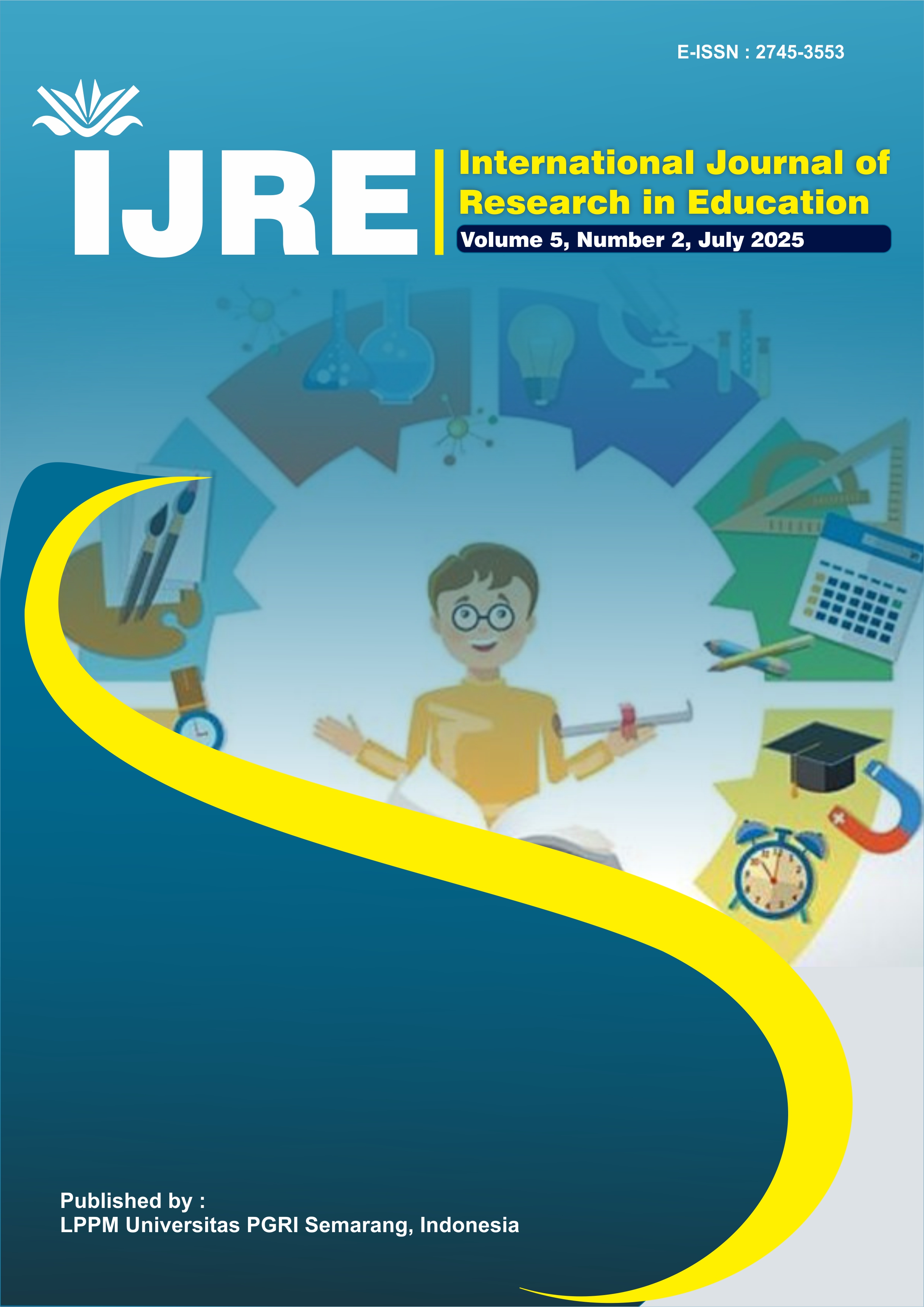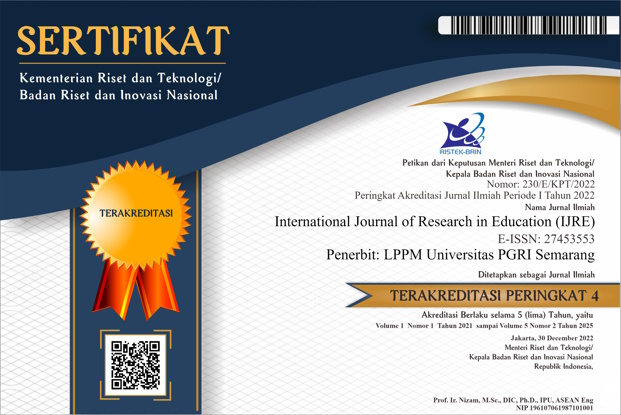The Impact of Social Media on English Language Learning: A Mixed-Methods Study
DOI:
https://doi.org/10.26877/j656ns21Keywords:
Digital learning,, EFL students,, English language learning,, Mixed-methods,, Social mediaAbstract
This study aims to analyze the impact of social media usage on English language learning among high school students, employing a mixed-methods approach. The research focuses on popular social media platforms such as Instagram, TikTok, Twitter, and YouTube, involving 64 tenth-grade students from a high school in Jakarta. In collecting quantitative data, a questionnaire was employed to measure the students’ perceptions of social media. To collect qualitative data, semi-structured interview was used, then analyzed with a thematic analysis. The findings indicate that social media positively contributes to the enhancement of vocabulary, speaking skills, and students' motivation to learn. However, challenges remain, including distractions from non-educational content and a lack of structured learning. The findings emphasize the importance of thoughtfully and specifically incorporating social media into the English language curriculum.
References
Abdulaziz Al Fadda, H. (2020). Determining How Social Media Affects Learning English: An Investigation of Mobile Applications Instagram and Snap Chat in TESOL Classroom. Arab World English Journal, 11(1), 3–11. https://doi.org/10.24093/awej/vol11no1.1
Abdullah, A. T. H., Al-Bawaleez, M. M. A., Azmi, M. N. L., & Hassan, I. (2022). Analysis of EFL Learners’ Language Proficiency Development Across Different Social Media Platforms. Theory and Practice in Language Studies, 12(9), 1756–1761. https://doi.org/10.17507/tpls.1209.07
Abhi Rama, M., Hamdani, Z., & Prihatini, C. (2023). Students’ Perception On The Use Of Tiktok As An Effective Learning Media In Improving Students’ Vocabulary. Journal on Education, 5(4), 17079–17086. https://doi.org/10.31004/joe.v5i4.4047
Aithal, A., & Aithal, P. S. (2020). Development and Validation of Survey Questionnaire & Experimental Data-A Systematical Review-based Statistical Approach. Psychology International. https://ssrn.com/abstract=3724105
Ande, R. H., Jaelani, A., & Retnowati, N. (2022). EFL Students’ Perception on The Use of Youtube as Online Learning Media During Covid-19 Pandemic. Journal of English Language Learning, 6(1), 71–80. https://doi.org/10.31949/jell.v6i1.2491
Apoko, T. W., & Waluyo, B. (2025). Social media for English language acquisition in Indonesian higher education: Constructivism and connectivism frameworks. Social Sciences and Humanities Open, 11. https://doi.org/10.1016/j.ssaho.2025.101382
Creswell, J. W., & Creswell, J. D. (2018). Research Design: Qualitative, Quantitative, and Mixed Methods Approaches (H. Salmon, Ed.; Fifth). SAGE Publications, Inc. https://spada.uns.ac.id/pluginfile.php/510378/mod_resource/content/1/creswell.pdf
Dengel, A., Gehrlein, R., Fernes, D., Görlich, S., Maurer, J., Pham, H. H., Großmann, G., & Eisermann, N. D. genannt. (2023). Qualitative Research Methods for Large Language Models: Conducting Semi-Structured Interviews with ChatGPT and BARD on Computer Science Education. Informatics, 10(4). https://doi.org/10.3390/informatics10040078
’Dörnyei, Z., ’Henry, A., & ’MacIntyre, P. D. ’. (2014). Motivational Dynamics in Language Learning (Z. Dörnyei, A. Henry, & P. D. MacIntyre, Eds.; berilustrasi, Vol. 81). Multilingual Matters. https://books.google.co.id/books?id=bU6uBAAAQBAJ&lpg=PP9&ots=2Y9BbICgUY&lr&hl=id&pg=PA1#v=onepage&q&f=false
Eyland, T., & Leung, A. (2024). A Purpose-Driven Approach to Apply Universal Design for Learning: A Focus on the “Why.” https://doi.org/10.2139/ssrn.4896583
Habibah, A., Asmawati, N., Fitriningsih, F., & Nurdin, N. (2021). The Effect Of Instagram In Learning English Vocabulary. Datokarama English Education Journal, 2(1). http://www.researchgate.net
Heitmayer, M., & Schimmelpfennig, R. (2024). Netiquette as Digital Social Norms. International Journal of Human-Computer Interaction, 40(13), 3334–3354. https://doi.org/10.1080/10447318.2023.2188534
Henry, A., & Liu, M. (2023). Can L2 motivation be modelled as a self-system? A critical assessment. System, 119. https://doi.org/10.1016/j.system.2023.103158
Hongsa, N., Wathawatthana, P., & Yonwilad, W. (2023). The Effects of TikTok Application on the Improvement of EFL Students‟ English-Speaking Skills. World Journal of English Language, 13(7), 77–88. https://doi.org/10.5430/wjel.v13n7p77
Ismail, N. M., Syahputri, V. N., & Irnanda, S. (2022). Gestures in Prolonging Semantic Memory of Young EFL Learners: A Serial Retention. Journal of Innovation in Educational and Cultural Research, 3(4), 714–721. https://doi.org/10.46843/jiecr.v3i4.366
Jabbari, N., Boriack, A. W., Barahona, E., Padrón, Y. N., & Waxman, H. C. (n.d.). The Benefits of Using Social Media Environments with English Language Learners.
Kaliisa, R., & Dolonen, J. A. (2023). CADA: a teacher-facing learning analytics dashboard to foster teachers’ awareness of students’ participation and discourse patterns in online discussions. Technology, Knowledge and Learning, 28(3), 937–958. https://doi.org/10.1007/s10758-022-09598-7
Leung, Y., Hsiao 梁耀南, T., Tzu-chia Chao, 蕭聰淵, & Wang, I. (2024, November). English Teachers and Japanese University Students’ Perceptions on Training Effectiveness for Online English Courses during the COVID-19 Pandemic. https://www.researchgate.net/publication/385700717
Lutfiyah, N., Nuraeningsih, N., & Rusiana, R. (2022). The Obstacles In Learning Vocabulary Of EFL Students. Prominent, 5(2), 114–125. https://doi.org/10.24176/pro.v5i2.8257
Malik, A., & Qureshi, F. (2024). Exploring the Impact of Social Media on English Language Learning: Opportunities and Challenges. Research Studies in English Language Teaching and Learning, 2(3), 176–186. https://doi.org/10.62583/rseltl.v2i3.50
Muftah, M. (2023). Impact of social media on learning English language during the COVID-19 pandemic. PSU Research Review. https://doi.org/10.1108/PRR-10-2021-0060
Naeem, M., Ozuem, W., Howell, K., & Ranfagni, S. (2023). A Step-by-Step Process of Thematic Analysis to Develop a Conceptual Model in Qualitative Research. International Journal of Qualitative Methods, 22. https://doi.org/10.1177/16094069231205789
Pranawengtias, W. (2022). Undergraduate Students’ motivation on English Language Learning at Universitas Teknokrat Indonesia. Journal of English Language Teaching and Learning (JELTL), 3(2), 27–32. http://jim.teknokrat.ac.id/index.php/english-language-teaching/index
Purwanto, A., Fahmi, K., & Cahyono, Y. (2023). The Benefits of Using Social Media in the Learning Process of Students in the Digital Literacy Era and the Education 4.0 Era. Journal of Information System and Management, 02(02). https://jisma.org
Samuel, S., & Pulizala, R. (2020). “Impact of Social media on English language learning” (Vol. 7). www.jetir.org
Sen, S., & Yildirim, I. (2022). A Tutorial on How to Conduct Meta-Analysis with IBM SPSS Statistics. Psych, 4(4), 640–667. https://doi.org/10.3390/psych4040049
Shaikh, S. S., HJ, J. A., & Hafeez, A. (2023). Social Media’s Impact on Academic Performance of Higher Faculties During Covid-19 Pandemic in Hyderabad, Sindh, Pakistan. Media Education (Mediaobrazovanie), 19(3). https://doi.org/10.13187/me.2023.3.480
Skulmowski, A., & Xu, K. M. (2022). Understanding Cognitive Load in Digital and Online Learning: a New Perspective on Extraneous Cognitive Load. In Educational Psychology Review (Vol. 34, Issue 1, pp. 171–196). Springer. https://doi.org/10.1007/s10648-021-09624-7
Taherdoost, H. (2021). Data Collection Methods and Tools for Research; A Step-by-Step Guide to Choose Data Collection Technique for Academic Data Collection Methods and Tools for Research; A Step-by-Step Guide to Choose Data Collection Technique for Academic and Business Research Projects. In International Journal of Academic Research in Management (IJARM) (Vol. 2021, Issue 1). https://hal.science/hal-03741847v1
Terceiro, L. (2024). The Interaction Designer as a Content Producer in the Social Media Era. https://www.diva-portal.org/smash/record.jsf?pid=diva2%3A1914315&dswid=-9119
Toyon, M. A. S. (2021). Explanatory sequential design of mixed methods research: Phases and challenges. International Journal of Research in Business and Social Science (2147- 4478), 10(5), 253–260. https://doi.org/10.20525/ijrbs.v10i5.1262
Van Den Beemt, A., Thurlings, M., & Willems, M. (2020). Towards an understanding of social media use in the classroom: a literature review. Technology, Pedagogy and Education, 29(1), 35–55. https://doi.org/10.1080/1475939X.2019.1695657
Wei, L. (2023). Artificial intelligence in language instruction: impact on English learning achievement, L2 motivation, and self-regulated learning. Frontiers in Psychology, 14. https://doi.org/10.3389/fpsyg.2023.1261955
Yang, H. (2020). Secondary-school Students’ Perspectives of Utilizing Tik Tok for English learning in and beyond the EFL classroom. https://www.clausiuspress.com/conferences/AETP/ETSS%202020/G7605.pdf
Zhang, X., & Zhang, R. (2023). Feedback, Response, and Learner Development: A Sociocultural Approach to Corrective Feedback in Second Language Writing. SAGE Open, 13(1).



